How to Stop Bad Things from Happening to Good Companies
Catching the right moment to take action when successful business models begin to wane requires skilled detection work and the courage to face reality. In the second article of a two-part series on value migration -- the process by which changing markets and new competitors threaten a company's equilibrium -- a system of early-warning diagnostics is recommended.
(originally published by Booz & Company)How do companies retain their competitive lead even as markets change? They do it by constantly rebuilding their businesses around their customers' needs. That requires intense analysis, early warning systems and an ever-widening field of vision.
The first article in this two-part series, appearing in Issue 3 of Strategy & Business, described why bad things happen to good companies. We pointed out that three interrelated factors were at work:
![]() The effects of value migration, usually experienced as a discontinuous change, require a company to develop a more customer-relevant business design.
The effects of value migration, usually experienced as a discontinuous change, require a company to develop a more customer-relevant business design.
![]() At the same time, the organization has calcified, making business redesign extremely difficult.
At the same time, the organization has calcified, making business redesign extremely difficult.
![]() Meanwhile, leadership, the swing variable that determines whether the company will act as it must, fails.
Meanwhile, leadership, the swing variable that determines whether the company will act as it must, fails.
The value migration process -- i.e., the flow of economic and shareholder value away from obsolete business models to new, more effective designs -- reflects changing customer needs that are beginning to be, and ultimately will be, satisfied by new competitive offerings. Market capitalization closely tracks this process, essentially transferring market value from the old to the new. While value migration is itself inevitable, companies can and have taken steps to deal with it.
Our purpose in this article is to help those poised on the brink of value migration to recapture value and energize their organizations so that they can move with -- and ahead of -- their customer base.
We begin by explaining why value migration is difficult to perceive and then introduce a system of diagnostics, which, when applied honestly and with discipline, illuminates the nature, rapidity and amount of value migration in your company. The answers you provide reveal your need to move. We suggest actions based on that assessment. We next explain why organizational calcification is difficult to see, then present another set of diagnostics, whose answers reveal your ability to move. We again suggest actions. Finally, we point out the critical role that leaders play in grappling with value migration and organizational calcification and conclude with examples of those who have succeeded.
Value Migration Is Difficult to Perceive
Value migration is hard to see when you are in the midst of a demanding business situation. The day-to-day tactical activities cloud the longer-term changes. And past success clouds the organization's clarity of vision. The greater the success, the less likely it is that value migration will be perceived. Perception is particularly hard when the new business design comes, as it often does, from beyond traditional competitors. Further, value migration is a complex process whose early phases are silent, subtle and typically asymptomatic. Detecting its signals requires skill and experience.
Narrow Competitive Field of Vision
Every company has a well-defined competitive field of vision, which is usually too narrow. Long periods of equilibrium only exacerbate the problem. A whole raft of "minor little players" operates just at the periphery. They are difficult to see because traditional competitors focus on each other and not on new entrants and "nontraditional" entities lurking at the industry's fringes.
These new competitors are also hard to determine, given such thinking as: we make steel, they make plastic; we produce gross rating points, they install coaxial cable; we sell high-end merchandise, they discount; and so forth. (See Exhibit I.)
Exhibit I
The Competitive Field of Vision
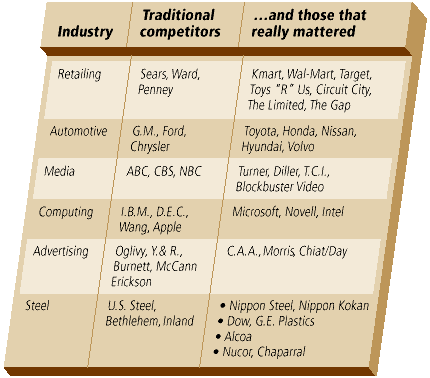
Narrow Customer Field of Vision
Value migration is triggered when the customer changes, a result of previous needs having been satisfied and new offerings appearing that suggest untried opportunities. Yet companies are often imprisoned by traditional concepts of who the customer is, and out-of-date assumptions about what the customer wants. They miss swings in customer needs and fashions. In the tire industry in the 1970's, the major players failed to note that customers were increasingly attracted to new offerings that promised more durability. Fifty years earlier, the Ford Motor Company was superbly organized to produce durable, reasonably priced cars, in black. When customers decided they wanted "frivolous" colors, Ford refused to comply and the General Motors Corporation stepped in.
More recently, in the computing field, customer decision-making moved from an information technology monopoly to any number of departments and then to individuals. Within the past few years, for many traditional companies, decision-making has been elevated from management information systems (MIS) to top management, as an increasing number of companies outsource their entire MIS operation, fueling a 25 percent growth rate in the outsourcing of data processing. Without clearly understanding how decision-making changes and how fast, value migration is extremely difficult either to predict or to perceive. (See Exhibit II.)
Exhibit II
The Customer Field of Vision
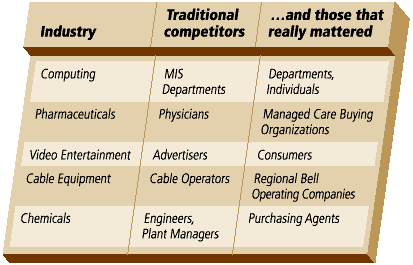
Lack of Perspective
The closer we get to our business and the more focused we become on executing our current business design, the more we lose the ability to maintain a perspective on our position. This is exacerbated by success, the number of people invested in the old successful business model and their unwillingness to confront the fact that business designs must be reconfigured to serve new realities.
No one disputes the value of facing reality. Yet so often, success affects our ability to hear clearly, to see clearly and to ask tough questions. Leaders who signal an unwillingness to "hear the truth" rarely become aware of what is, in fact, going on. (How many people who actively disagree with current practice get promoted?) Thus, senior managers join the conspiracy to subvert the recognition of market realities, even though "protecting" the C.E.O. is exactly the opposite of what is needed.
Conversely, when "bad things" do begin to happen, leaders frequently try to short-circuit their organizations and immediately confront customers directly. However, C.E.O.'s, except in very small companies, cannot on their own fully perceive value migration and its underlying customer and competitor changes. They need a supple and forward-looking organization working with them.
A Complex, Silent, Yet Measurable Process
As Exhibit III illustrates, in the earliest stage of the process, several enabling factors begin to fall into place. These factors always reflect two common denominators: evolving customer needs and new competitive options becoming available to customers. This needs-and-options interaction initiates value migration.
Exhibit III
The Value Migration Process
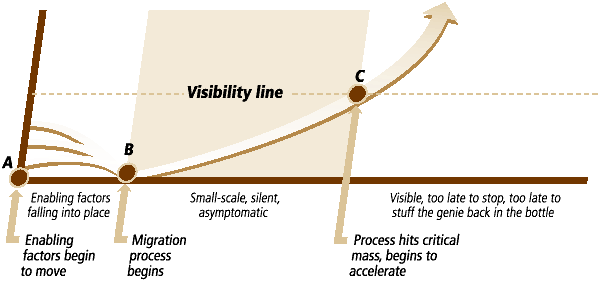
When the factors join (point B), migration begins, but this movement occurs well below the "visibility" line. Inexorably, the process hits critical mass (point C), with the momentum hurling it above the visibility line. Unfortunately for the industry's incumbents, when the process becomes visible it is already often unstoppable.
Although the earliest signals of value migration are difficult to detect, they do trigger measurable indicators that constitute evidence that the process is under way. The diagnostic questions are designed to provide you with these early measurable signals of value migration and to enable you to assess the urgency of the "need to move."
While these questions are straightforward, their effectiveness lies in how they are answered. There is, in fact, a powerful motivation to make biased responses: protect the current system. The usefulness of these diagnostics, therefore, is in direct proportion to the honesty with which the answers are given. We suggest for both sets of diagnostics that:
![]() managers respond to the questions individually;
managers respond to the questions individually;
![]() answers should be quantified as much as possible, to encourage comparisons over time and among different managers;
answers should be quantified as much as possible, to encourage comparisons over time and among different managers;
![]() the individual results should be thoughtfully and vigorously discussed so that they can be integrated into a joint conclusion.
the individual results should be thoughtfully and vigorously discussed so that they can be integrated into a joint conclusion.
Value Migration Questions: The Need to Move
1) List your most important product and customer service attributes for five years in the future, for today and for five years ago.
Rate each attribute on a 1-to-10 scale of importance (10 being most important). Rate your company on each attribute for today only. Rate each of your "traditional" competitors on each attribute for today. Rate each "nontraditional" competitor for today.
You begin with the future to discard the baggage of the past, thereby minimizing the changes occurring and insuring a more accurate list of attributes.
2) Identify leading-edge customers and your market share with them over the past few years. Determine what makes these customers "leading edge."
If you do this every year, trends will become obvious: when you begin to lose market share among leading-edge customers, you are approaching the danger point in value migration.
3) Identify your worst-case scenarios. What competitive situation do you fear most? Why?
4) What is your market share with:
![]() growing customer market segments;
growing customer market segments;
![]() emerging customer segments;
emerging customer segments;
![]() the most profitable customers;
the most profitable customers;
![]() the most influential customers in your industry.
the most influential customers in your industry.
Determine your customer loyalty and retention for these segments.
When you have made this assessment, you have determined your quality of market share.(1)
5) What is your customers' share of their industry?
Is the ratio of your served market to the total market increasing or decreasing? Many companies experiencing dramatic value outflow are actually increasing their share of their served market, yet their served market itself may be shrinking (e.g., disk drives for mainframe computers).
6) What is your ratio of profit from new products? How does it compare with your traditional and nontraditional competitors, and with your past performance?
7) What is the percentage of new product failures? What is the trend? How does this compare with traditional and nontraditional competitors?
For this diagnostic, you might need separate ratios for old product extensions and flankers as opposed to truly new offerings.
8) Map the previous value migration that enabled you to gain the position you now have. Who was the vanquished defender? Why?
9) What percentage of your business is done in the last week or two of each quarter? What percentage of your sales is sold on discount?
The Need to Move: Actions
If your organization scores low on the customers' most important future attributes, if your share with leading-edge customers is dropping, if your quality of market share is declining, if your customers' business is shrinking, if profits from new products are low, if most revenue comes in at the end of the quarter and most products are sold on discount, then your company's need to move may be an 8 or a 9 on a scale of 1 to 10. If all these indicators are lower, the need to move right now may be low but the need for continued monitoring remains high. In either event, and particularly if you need to move soon, we recommend the following actions:
1) Map your industry's value migration process. Value migration mapping should be done early enough so that your organization can take necessary action. Effective mapping uses the market capitalization/revenue measure to create a first approximation of relative position, but then elucidates the movement behind the ratios. It will assign approximate market capitalization/revenue indexes to business units within your company's structure, to understand the relative health and profit vitality of the major components of your business.
The basic questions you need to answer are: Where is your company (and its major business units) positioned on the market capitalization/revenue slope? Why? How is the ability to earn a profit changing in the industry? Where is it moving from? Where is it moving to? What factors are driving the movement? Is the migration of value complete and irreversible (e.g., the value outflow from minicomputing), or is it partial? How rapidly is value migrating?
Understanding the direction, velocity and magnitude of value movement is critical. Prior examples can be extremely helpful. In computers, the value flow was linear for several decades; in steel it was multidirectional toward different competitors. (See Exhibit IV.) Past examples can also help create a framework for estimating the speed and magnitude of market capitalization shifts for your industry. (See Exhibit V.)
Exhibit IV
The Differing Paths to Value Migration
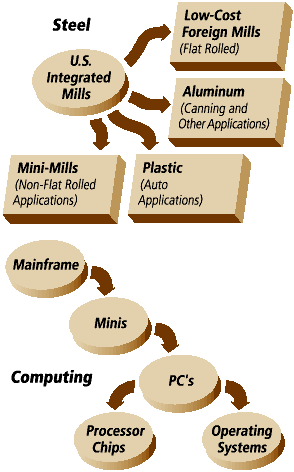
Exhibit V
Market Capitalization Decline
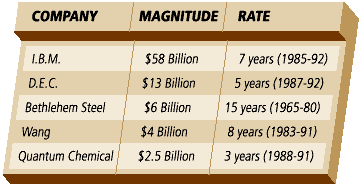
Although value migration mapping is difficult for reasons both analytical (the past is easier to "predict" than the future) and organizational (the power of denial), you can apply the experience and frameworks established in prior cases (e.g., steel, media, retailing, airlines). These help you develop an accurate reading of your situation, gain a clear sense of the rate at which the organization needs to move and assess the level of risk it should assume. (See Exhibit VI.)
Exhibit VI
Value Migration Analysis
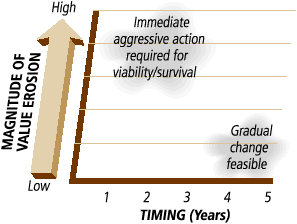
2) Revisit the customer base; map the trajectory of customer needs. In trying to understand and anticipate value migration, your most powerful ally is the customer. But conventional approaches to customer analysis defeat its strategic purpose. They rely on market research methodology executed by junior professionals to create a profile of today's customer needs and preferences.
The approach we recommend involves a shift from traditional questions and modes of inquiry to the more troubling ones. It means not asking questions such as, Am I competitive?, but, Am I competing in the right way? Not, What do I need to know?, but, What am I afraid of finding out? This approach also involves a shift from junior professionals to senior managers as the key participants, and a shift from the standard tabulations of market research to a strategic exploration of the trajectory of the customer's needs and preferences. What you want is the moving picture of how those needs have changed over the last several years and will change into the next half-decade. (See Exhibit VII.) Finally, it involves a shift from a purely analytical process to one that also applies creativity to anticipating how customers will move.
Exhibit VII
Trajectory of Customer Needs
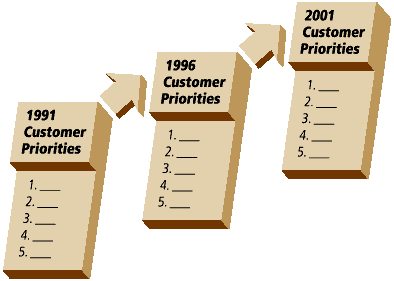
Summoning this type of creativity requires a genuine, ongoing dialogue with your tough, demanding customers. You need a sophisticated understanding of customer economics (how do they make money?) and an appreciation of the competitive and other pressures that customers must respond to. When you make the investment in understanding customers' economics and strategy, you begin to appreciate their future needs and preferences and to shape solutions that respond to them. Just as important, you begin to anticipate when major transitions in the structure of customer needs and preferences will occur, and when a fundamental transition in your company's business design will be required.
Honestly determining the trajectory of customer needs reveals that the customer is saying (in effect), "I don't care about your historical abilities to ____ [fill in any one of a long list of obsolete skills, e.g., provide minicomputer architecture design brilliance]. My business has changed, my economic priorities have changed. What I really care about is ____. What I will pay a premium for is ____."
Implicit in this information is that the customer is discounting traditional skills and valuing new ones. This leads inevitably to the next action, a reassessment of your company's business design.
3) Compare your business design to that of competitors. Begin by characterizing your own business design in terms of technology, organizational configuration, degree of vertical integration and value-recapture mechanism. Compare your approach to that of competitors: traditional, newcomers and "nontraditionals." Does the economic logic that originally led to your business design still hold true?
Then compare your design to what you would do if you were entering the business today. How would the design differ? Why?
A comparative perspective on business designs frequently suggests that the company's cost structure is too high. When value migration occurs, changing the cost structure is critical. But how it is changed makes all the difference.
Typically, cost reductions are delayed, are across-the-board (eliminate 10 percent, say, from every department) and are not oriented toward what the business design should be at the end of the reduction effort. Consequently, the effort usually fails. (See Exhibits VIII and IX.) In fact, cost reduction and internal re-engineering approaches more often than not misconstrue the fundamental nature of the problem. The point is not to become more efficient at activities that are losing customer and economic relevance, but to alter the business design in a way that matches customer demands and is consistent with the new economic order in your industry.
Exhibit VIII
The Aftershocks of Downsizing
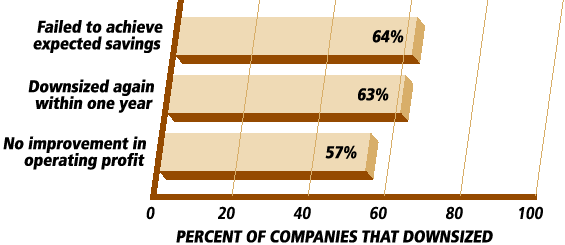
Exhibit IX
Layoffs/Downsizing and Market Valuation
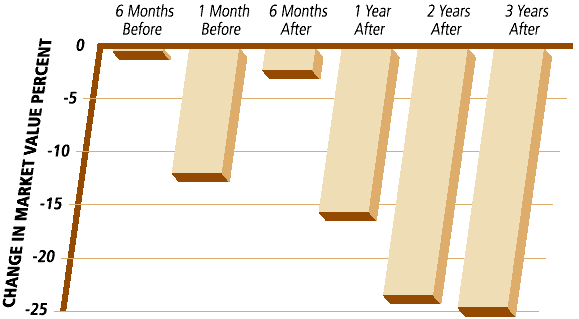
Sources: S.&P. 500 for large stocks, Nasdaq composite for smaller stocks
Changing your business design to anticipate value migration requires you to ask: Which capabilities, functions and competencies are no longer relevant? Which ones still retain their value (from a market perspective)? Which new functions and capabilities must be developed or acquired to be successful in the next cycle of customer needs and buying behavior?
The difference in mind-set and outcomes between a delayed, across-the-board cost reduction approach and a business redesign approach driven by value migration can be illustrated by two companies, both experiencing the flight of value away from traditional proprietary minicomputer design and manufacturing activities. (See Exhibit X.)
Exhibit X
Cost Reduction -- A Matter of Timing
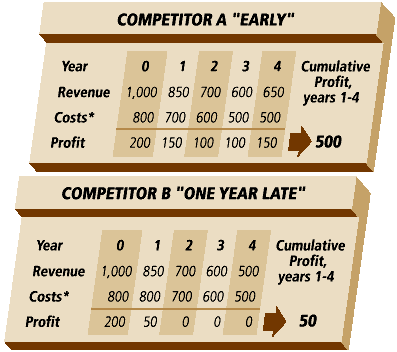
*Both competitors had a similar cost structure:
- Manufacturing: $400 million
- R.&D.: $100 million
- Sales: $200 million
- Overhead: $100 million
The first competitor, A, moved quickly to reduce costs and protect its resource-generating ability despite rapid revenue decline. The second competitor, B, continued to hope that its business would be viable, and moved much more slowly. It thus generated no resources for reinvestment in a new business design.
Competitor B's mind-set was reflected in the mix of its cost reductions. It cut selling costs by 30 percent, R.&D. by 30 percent, overhead by 40 percent and manufacturing by 40 percent -- a classic across-the-board approach. By contrast, Competitor A reduced selling expenses by 70 percent, making a traumatic but necessary shift from a direct sales approach to lower-cost distribution channels. It cut overhead by 60 percent, manufacturing by 30 percent and R.&D. by just 20 percent. Within R.&D., the mix of expenditures shifted from hardware to software, and within hardware from proprietary to open systems. By the fourth year, its strategy was generating strong new revenue and profit growth, while Competitor B's revenues continued to decline to bankruptcy.
Major, painful cost reductions are inevitable when business designs become rigid and lose their economic relevance. The best defense is to ask at the time when the strategy is set and the business design is developed, how long will this strategy and this design be good for? History shows that this crucial question must always be asked, and in today's business landscape it must be asked frequently and insistently. Crafting the right design for the next phase of value migration must rise to the top of management's agenda.
4) Begin modifying your business design before you are forced to do so. The cost reduction example above illustrates why the business redesign process is best started early, before your freedom becomes dangerously constrained. Three interrelated actions are particularly valuable here:
![]() Practice creative under-investment in the old design. Radically cutting off investment funds for businesses that are current sources of cash flow is always a dangerous strategy. If you begin under-investing early enough, however, it is unnecessary. The key is to balance maintenance (and improvement of competitive position) against the inevitable tendency to overshoot investment in the old design. Thus, it becomes critically important to use the capital budgeting process to ask, for example: Do we need another mainframe factory, etc.? Or are we better off reducing our capacity modestly and investing to improve our cost position?
Practice creative under-investment in the old design. Radically cutting off investment funds for businesses that are current sources of cash flow is always a dangerous strategy. If you begin under-investing early enough, however, it is unnecessary. The key is to balance maintenance (and improvement of competitive position) against the inevitable tendency to overshoot investment in the old design. Thus, it becomes critically important to use the capital budgeting process to ask, for example: Do we need another mainframe factory, etc.? Or are we better off reducing our capacity modestly and investing to improve our cost position?
Creative under-investment in the old design aggressively questions the logic of capacity additions for that design. It causes less to be invested, and it redirects investment from capacity expansion toward cost improvement and demand generation.
![]() Acquire the relevant new capabilities. Mapping your industry's value migration process helps illuminate what new capabilities will be essential for continued viability and success. Broadcast networks need to develop cable programming positions and expertise. Makers of mechanical equipment need to acquire electronic and electromechanical capabilities. Strategy consulting firms must learn implementation. The issue is not just building on core competencies but understanding what new competencies and capabilities must be developed to be successful in the next phase of the customers' needs cycle.
Acquire the relevant new capabilities. Mapping your industry's value migration process helps illuminate what new capabilities will be essential for continued viability and success. Broadcast networks need to develop cable programming positions and expertise. Makers of mechanical equipment need to acquire electronic and electromechanical capabilities. Strategy consulting firms must learn implementation. The issue is not just building on core competencies but understanding what new competencies and capabilities must be developed to be successful in the next phase of the customers' needs cycle.
Creative under-investment in the old business design helps fund the acquisition of new capabilities. Usually, however, the issue is not money but mind-set. "We stick to our knitting," the philosophy goes. Fair enough, unless knitting is becoming irrelevant and customers will no longer permit you to profit from it.
![]() Protect your new businesses. New capabilities can come from skilled professionals or from new businesses. Many successful organizations, however, have a powerful aversion to new business designs, which often look different, reflect different norms and values and succeed in different ways. If a new business is commingled with the existing structure, it may be drawn into the gravitational pull of the old ways of doing things and be crushed.
Protect your new businesses. New capabilities can come from skilled professionals or from new businesses. Many successful organizations, however, have a powerful aversion to new business designs, which often look different, reflect different norms and values and succeed in different ways. If a new business is commingled with the existing structure, it may be drawn into the gravitational pull of the old ways of doing things and be crushed.
Astute C.E.O.'s have gone out of their way to protect new business designs, keeping them separate from the base organization until they reach critical mass and can then be integrated into the company's overall structure. One pharmaceutical company kept its nascent biotechnology unit outside the boundaries of its traditional R.&D. organization so it could move at the rapid pace set by leading biotechnology rivals. In a printing company, the C.E.O. kept a new service delivery unit separate until it was strong enough to be a partner, rather than a servant, of the base organization. In each case, the company's overall position with customers improved dramatically, given its broadened spectrum of skills for solving the customers' problems.
5) At transition time, move quickly. As we have repeatedly stressed, the transition from equilibrium to value outflow can happen very quickly. I.B.M. made $6 billion in 1990 and lost $5 billion in 1992, for example. Although traditional organizational approaches may argue for gradualism, in many value inflections the external rate of change is so discontinuous that gradualism can be fatal. Better to say "the game has changed, perhaps abruptly, and we must change with it," than to debate and incrementalize your way into stagnation or oblivion.
Rapid action is of the essence in managing value migration for several reasons. There is usually not enough room in the new value "space" to accommodate all the traditional players plus the new competitors. The first mover also gets the lion's share. What's more, the odds of implementing a successful new business design are far higher for a company if it begins its transformation as value migration is just starting to accelerate. With a large market capitalization, companies can insure the financing required to move in new directions and acquire the resources and capabilities needed to thrive in the new environment. After customer value migration has begun, however, market value shrinks, financing is more difficult and expensive to obtain and competitors are likely to have already staked out strong positions in the new areas of profit growth. Eventually, a company crosses the point of no return; it is unable to create a new business design that can achieve profitability and heads either for bankruptcy or long-term stagnation.
The question is, having determined the need to move, have you the ability to move?
Organizational Calcification Is Difficult to Perceive
Organizational calcification is an internal force as powerful as the pressures gathering strength in your external world. It is hard to see because its causes and effects are multidimensional as well as incremental along each dimension. When the need to move becomes extremely urgent -- when a discontinuity is experienced -- organizational calcification can be fatal. It is therefore vital to monitor calcification and to arrest and ideally reverse it before it becomes an insurmountable obstacle.
Answers to the following diagnostic questions and their related measurements will give you a metric for calcification in your company. Again, the information is useful only if answers are honestly provided.
Organizational Calcification Questions: The Ability to Move
1) Determine over time, and in comparison with your traditional and nontraditional competitors:
![]() the ratio of production and/or service providers to total employment;
the ratio of production and/or service providers to total employment;
![]() the ratio of salespeople to total employment;
the ratio of salespeople to total employment;
![]() the ratio of production, service providers and salespeople to total employment.
the ratio of production, service providers and salespeople to total employment.
2) Calculate sales and profit per employee. Compare these ratios to the past in your company and to your "leanest" traditional competitor and leanest similar company.
3) What is your ratio of forced turnover over the last five years? What is the ratio of voluntary turnover in the last five years? What is the ratio of selected professional and managerial applicants who turn you down?
4) For each year for the past five years, determine the ratio of those managers predisposed to agree with your current approach to those managers predisposed to challenge it.
5) What is the ratio of experienced people hired from outside over the past five years?
6) What is the experience distribution for all employees, direct supervisors of production or customer service personnel, production and customer service providers and salespeople? Compare this distribution to five years ago.
7) What is the trend in the speed of:
![]() making standard decisions;
making standard decisions;
![]() new product development;
new product development;
![]() order cycle fulfillment;
order cycle fulfillment;
![]() other business processes (e.g., credit checks, capital budget authorizations, marketing program formulation and implementation).
other business processes (e.g., credit checks, capital budget authorizations, marketing program formulation and implementation).
8) How much top management time is spent:
![]() visiting customers (the users and buyers of the product, not just customer top management, who do not directly choose or use the product);
visiting customers (the users and buyers of the product, not just customer top management, who do not directly choose or use the product);
![]() making calls in the field with salespeople;
making calls in the field with salespeople;
![]() sitting down with customer service representatives and other front-line customer response people;
sitting down with customer service representatives and other front-line customer response people;
![]() getting out to the plant, store or other operating sites without protection from other senior executives.
getting out to the plant, store or other operating sites without protection from other senior executives.
9) Rate all your direct reports and the next level of managers on loyalty and competence using a 1-to-10 scale. (See Exhibit XI.)
Exhibit XI
The Loyalty-Competence Matrix
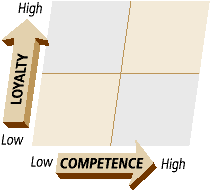
The Ability to Move: Actions
If your organization is overemployed, over-"staffed" and overloaded with loyalists, and your managers are not out where it counts, your ability to move will be a 1 or a 2 on a scale of 1 to 10. The organization has become dangerously incapable of anticipating or responding to pressures from outside. Further, when the "need to move" is a 10, and the "ability to move" is a 1 or a 2, crisis looms. (See Exhibit XII.) In either case, we recommend the following actions, which are listed and then discussed:
1) Tie employee growth to the lesser of sales or profit growth.
2) Outplace poor-performing employees in the bottom tenth of the organization.
3) Outplace people who are more loyal than competent.
4) Increase staff hiring more slowly than total employee growth, so that the ratio of line employees (who actually sell, service and produce) to staff employees gets bigger.
5) Hire and maintain a critical mass of those who constructively challenge the current business design.
6) Invest in functions critical to the future to energize the organization. Increase total human resources (number and talent level) in those functions.
7) Acquire new skill sets essential to customer-defined future needs.
Exhibit XII
Need/Ability to Move
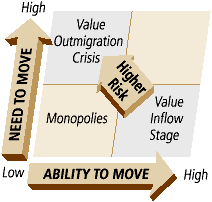
Excessive employment growth is a pernicious cause of calcification and must be vigorously fought. At a minimum, increase employment no faster than the lesser of profit or sales growth rates in real terms, not counting unusual growth in sales or profits because of a banner year or extraordinary accounting changes. It is best to measure sales and profit growth rates as conservatively as possible. Benchmark the numbers for sales and profit per employee against the leanest similar company, which may or may not be a competitor.
Managing the quality of employees is as important, if not more so, as managing their number. Lifetime guaranteed employment is directly at odds with sustainable employment levels and maintaining a competitively strong organization. I.B.M.'s impossible-to-implement guaranteed employment has not been a guarantee to those fired in droves in the early 1990's.
Guaranteed employment is unjust to the individual employee who is not performing well, but who may perform well elsewhere. It is unjust to the employee's co-workers, too. They not only must carry that person's load, but they are also vulnerable when value migrates and the company is forced to jettison the wheat and the chaff simultaneously. And ultimately, keeping on people who are more loyal than competent is unjust to the organization, for they are less able to see the truth and less willing to share it with you.
Do not let "affordability" lower performance standards at any level. The Microsoft Corporation has shown the power of such an approach. Its disciplined policy of pruning the bottom 5 percent of its work force every six months insures that all employees are carrying their full load. Such a continuous improvement program is much more fair and humane than the wholesale firings that invariably occur when constant internal vigilance is not asserted.
The only way to insure that employees are held to high performance standards even when life at the company is relatively stable is by having a complete performance-oriented system. Strong, fair, clear and candid performance appraisal and feedback are critical to avoiding calcification. Pay-for-performance is an important part of this system because it provides a strong backbone for making hard decisions.
The outplacement system must be as good as the recruiting system. It should systematically support employees in their effort to find a position that takes maximum advantage of their skills, and should provide a reasonable chance for financial security. Almost any severance package is cheaper in the long run than keeping poorly performing workers.
The number and quality of employees are important, but more must be considered. The relationship of employees to their employer and the nature of the employees must also be managed. By "nature," we mean type of work, experience and thought process.
Every organization needs some staff people to support the line people, who actually sell, service and produce, but having too many definitely contributes to calcification. Staff growth should be below the lesser of profit, sales or line employment growth. Like total employment, it should be benchmarked against the leanest similar company. Requests for additional staff hiring should be subject to more stringent controls and treated more cautiously than requests for line hires.
Hiring at all levels should include managers from other industries to encourage open-thinking systems. The board of directors should likewise comprise strong-willed people with an eclectic portfolio of skill, experience and outlook. Such a hiring approach combined with pruning based on performance not only maximizes employee capability, it helps to insure that the average age of the work force remains relatively constant. Firing only older employees is illegal in the United States, and inhumane. Pruning and the right kind of hiring at all levels insure a more balanced, flexible, change-responsive work force.
Finally, a company must hire "outside the box" thinkers as well as those who can do the present work better. The goal, again, is a dynamic balance. We do not know of a simple paper-and-pencil test for absolutely determining these candidates. But some companies attract more than their share of iconoclasts, and others hire only those who think as their managers do. Competent interviewers apparently distinguish between those who advocate the company way and those who might constructively challenge it.
As value migrates, energizing the organization requires reallocating human resources from traditionally powerful functions to those that will be critical to future success. For example, in the pharmaceutical industry during the 1960's and 70's, the value of breakthrough products (often serendipitous) and me-too offerings was maximized through astute pricing, intensive sales efforts and aggressive marketing campaigns. More than half of industry profitability was driven by these functions. In the 90's, however, pricing flexibility is collapsing, and the degrees of freedom for sales and marketing are becoming severely circumscribed. Relative importance will shift to discovery, development and account management for key customers (managed care organizations, other large purchasers and the Food and Drug Administration).
The value migration process determines not only which functions will rise in importance, but which new skills and technologies are necessary to meet future customer needs. Professionals with future-relevant skills must become a part of the organizational fabric. Without integrating new skills into the company's business design, that design will become increasingly irrelevant to customers.
The above actions help create a work force, including a management team, capable of dealing with the discontinuous change that value migration implies. The team must identify the drivers of value migration as it approaches, and must understand the mechanisms by which the drivers interact with one another. The team must also form the company's response early. Leaders can help in three additional ways:
![]() Get the organization to face outside. It is vital to hire people with different experience and the capability to think outside conventional confines. External goals related to the marketplace such as share of market, quality of market share, customer satisfaction and customer retention provide the right type of compass setting. Constant scrutiny of performance against such goals is critical.
Get the organization to face outside. It is vital to hire people with different experience and the capability to think outside conventional confines. External goals related to the marketplace such as share of market, quality of market share, customer satisfaction and customer retention provide the right type of compass setting. Constant scrutiny of performance against such goals is critical.
![]() Insist on "out of the box" market research/exploration that includes asking tough questions directly to your toughest customers. What are they telling you that you don't want to hear? What are new emerging competitors in different industries or locales telling you, via these customers, about new approaches?
Insist on "out of the box" market research/exploration that includes asking tough questions directly to your toughest customers. What are they telling you that you don't want to hear? What are new emerging competitors in different industries or locales telling you, via these customers, about new approaches?
![]() Concentrate on discontinuous improvement as well as continuous improvement. The quality movement in its many forms has been, and is, fundamental. But too often it focuses on doing the old things (in a strategic sense) better. Value migration puts a premium on doing new things. A major tension in the organization is between doing new things and doing the old things better. Both are important. A strategy focusing only on continuous improvement is dangerously incomplete.
Concentrate on discontinuous improvement as well as continuous improvement. The quality movement in its many forms has been, and is, fundamental. But too often it focuses on doing the old things (in a strategic sense) better. Value migration puts a premium on doing new things. A major tension in the organization is between doing new things and doing the old things better. Both are important. A strategy focusing only on continuous improvement is dangerously incomplete.
Mobilizing Leadership
Implicit in the recommended actions for responding to the need and ability to move is the crucial importance of asserting leadership. Effective leaders look beyond their organizations toward their customers and competitors -- the key groups, along with distribution channels and business partners, that will determine the destiny of the company. These leaders, and their top managers, will also look deeply into their organizations, listening to and talking with production workers, who may understand quality problems better than the vice president of manufacturing, and with those in the sales area, who may be more familiar with what customers want than is the marketing vice president. And effective leaders and their top managers will dig into customers' organizations to talk with -- and listen to -- those who actually use their company's offerings, and they will ask the hard questions. Overall, effective leaders and their organizations are poised for the future.
The board must assert itself, too. If the company's leader is wedded to the old business design, is unable to examine the assumptions behind it and thus cannot provide, or even positively respond to, the "out of the box" thinking needed to bring about change, the board may have to go outside the organization for a replacement. Facing the realities of firing the C.E.O., writing down fixed assets and addressing the development of a new business design are not easy. But, in today's world, such actions may be needed to meet discontinuous change.
Sometimes, the only solution is long-term liquidation. Yet top management and boards are almost always unwilling even to face the possibility of liquidation.(2) But it must be faced, if only to provide a base level from which to think through the issues.
The Job Is Hard . . . But It Can Be Done
Maintaining external responsiveness and internal suppleness to enable you to serve and shape markets demands a remarkable constellation of talents. And a little luck along the way is always welcome. Because these tasks are hard, most businesses fail. They don't all necessarily go bankrupt; rather, they fail to reach their full potential. History shows, however, that the job can be done right. Success can be sustained over long periods, and leaders can lead. Companies can move before they must. We present some examples to provide guidance and inspiration.
John Jacob Astor immigrated to the United States from Germany in 1784, with hardly a penny to his name. When he died, in 1848, he left a fortune of about $20 million, the first American estate numbered in eight figures.
Astor began in the fur trade, becoming an expert in its every aspect. His American Fur Company, capitalized at $1 million, was one of the first American businesses to be incorporated. In 1834, after a half-century in the business, Astor withdrew. Less than a decade thereafter, the bottom fell out of the fur market. What happened?
Astor had sensed that expenses would inexorably rise. What originally made the fur business so attractive was the abundance of easily trapped animals. The explorers Lewis and Clark had marveled at encountering the "richest and most delicious fur in the world . . . deep silky in the extreme and strong." And this was Astor's for the taking. By the early 1830's, however, too many of the best animals had been killed off, and Astor's agents had to work harder to get fewer of them.
Astor thought the unthinkable and acted. Refusing to be guided by sentiment, he divided his company into two businesses and sold them off. Within seven years, one was in bankruptcy. And what did Astor do with the money from this sale? There is no substitute for vision, and Astor saw a future in New York City's real estate. Shortly before his death, he observed: "Could I begin life again . . . I would buy every foot of land on the island of Manhattan."(3) He had managed to buy enough by 1848 so that his descendants are still wealthy people.
Astor was remarkable but not unique. John D. Rockefeller's dominance over the oil industry in the 1860's and early 1870's was substantially based on his ability to dictate the terms of business to the railroads, which transported the nation's oil. In the late 1870's, however, oil pipelines were proving far more cost efficient. Rather than bemoan his fate, Rockefeller bet his company on building a pipeline of his own.(4) The result? In 1911, Rockefeller's fortune was estimated at $900 million. The gross national product of the United States that year was a little over $35 billion.
Leaders who assert themselves and face the truth are found in every industry. For example, under Robert Wood's inspired leadership, Sears, Roebuck & Company moved from catalogues to counters in the late 1920's. It traveled from the cities to the suburbs in the late 1940's. Mr. Wood then directed Sears to the Far West while his traditional competitor, Montgomery Ward, dawdled near the Great Lakes. In 1959, Sears had 17 stores in the exploding Los Angeles market, and Ward had none.(5) The result? Sears gained a lead on the rest of the retailing world, which it has only recently thrown away.
Facing the truth is never painless. The success of Levi Strauss & Company as top gun in the jeans market made it a $4 billion operation employing 48,000 people by the early 1980's. Success and "affordability" enabled it to dabble in an array of diversifications, hiring thousands of people along the way. Meanwhile, significant changes in the company's customer base threatened its success.
When Robert D. Haas became president and C.E.O., in 1984, he faced "a company in crisis,'' he later recalled. "Our sales were dropping, our international business was heading for a loss, our domestic business had an eroding profit base, our diversification wasn't working and we had too much production capacity.'"(6)
Among other actions, Mr. Haas took the company private and reduced employment by 17,000, nearly a third of the work force. And the business was redefined.
Levi's success had depended on 18-to-25-year-old jeans buyers, the "baby boomers," who were growing older, more affluent and rounder. While Lee's, Levi's archrival, continued to define its market as the 18-to-25-year-old, thus placing itself into a declining segment, Levi's chose to stay with its customers. It created entire new product lines that met the evolving needs (and shape and size) of this group. While it remained competitive in the 18-to-25 jeans market, it became dominant in the over-25 group. The result? From 1987 to 1990, Levi's sales and profit grew by $1 billion and $300 million, respectively; Lee's revenues, meanwhile, declined by $300 million and its operating profit fell by $100 million.
Perhaps no story is more challenging than that of the Intel Corporation.
Intel was founded a mere quarter-century ago by Gordon Moore, now chairman, and the late Robert Noyce. Its founding strategy, according to Andrew Grove, Intel's third employee and today its president and C.E.O., was to be a "silicon-based [company with a] distinctive competence in memory products." It would supply replacement parts for mainframe computers.
For more than a decade, the strategy was successful. Inevitably, however, Intel's DRAM (Dynamic Random Access Memory) chips business became commoditized. While this was not surprising, given industry evolution, it was surprising that Intel spotted this development and redeployed its assets in time to gain a new competitive advantage in a different part of the industry.
How did that happen? First, middle management saw the changes coming. Second, the rule at the company was freedom of speech: "No one at Intel was ever told to shut up," Mr. Grove said. Third, not only were smart managers encouraged to speak their minds, but their teammates -- from the top through the ranks -- understood the necessity of listening, and of acting upon what they learned.
In 1984, Mr. Grove said, "I recall going to Gordon [Moore] and asking him what new management would do if we were replaced. The answer was clear! Get out of DRAM's. So I suggested to Gordon that we go through the revolving door, come back in and just do it ourselves."
Yet it was terribly difficult for many people to think of Intel as anything but "the memory company" -- in other words, to think "out of the box." Describing the possibility of abandoning the business, a manager said: "It was kind of like Ford deciding to get out of cars." Yet Mr. Grove persevered. The result? Intel's hard-driving competitiveness is the stuff of legend.(7)
Astor. Rockefeller. Wood. Haas. Grove. Did any of these people use our diagnostics in reformulating their businesses? Of course not. Business is not that simple; it is not a matter of painting by numbers.
But if you explore the histories of these and other successful executives who managed to prevent bad things from happening to their good companies, what you discover is that many of the guidelines we offer were, in fact, implicitly followed. Not every guideline. Not all the time. But enough right actions were taken at enough key moments to make the difference. We have presented our diagnostics as a tool to help make their implicit thinking explicit and thus transmittable.
What these business leaders accomplished demands analytical acumen, self-awareness and courage. It most of all involves facing reality. As Robert Haas noted, in response to a question about championing such values as empowerment when workers fear losing their jobs: "There is an apparent contradiction but not a real one, because our most basic value is honesty. If we have too much capacity, it's a problem that affects the entire company. Sometimes, the only solution is to close a plant, and if we don't have the guts to face that decision, then we risk hurting a lot of people -- not just those in one plant. We need to be honest about that."(8)
The success of such leaders illustrates that the difficulties involved in changing with the market can only be met with insight and courage. But changing with the market -- especially changing a step ahead of the market -- will stop bad things from happening to your company. ![]()
Reprint No. 97104
FOOTNOTES
(1) For more on this, see Benson P. Shapiro and Adrian J. Slywotzky, "Leveraging to Beat the Odds: The New Marketing Mind-Set," Harvard Business Review, September-October 1993, pp. 97-107, Reprint No. 93510.
(2) Chris Argyris, "Overcoming Organizational Defenses" (Allyn & Bacon, 1990).
(3) Alfred D. Chandler Jr. and Richard S. Tedlow, "The Coming of Managerial Capitalism: A Casebook on the History of American Economics Institutions" (Irwin, 1985), pp. 55-82.
(4) Ibid., pp. 343-371.
(5) Richard S. Tedlow, "New and Improved: The Story of Mass Marketing in America" (Basic Books, 1990), pp. 259-343.
(6) Robert Howard, "Values Make the Company: An Interview With Robert Haas," Harvard Business Review, September-October 1990, p. 136.
(7) Robert A. Burgelman, "Fading Memories: A Process Theory of Strategic Business Exit in Dynamic Environments," Administrative Science Quarterly, Vol. 39 (1994), pp. 24-56.
(8) Robert Howard, op. cit., p. 143.



